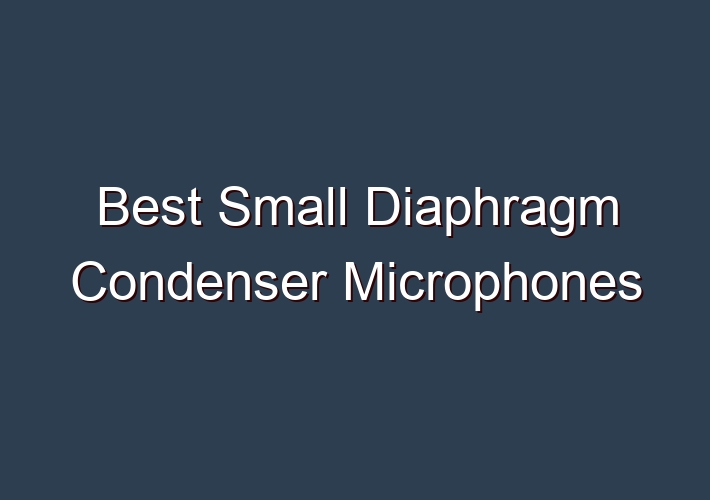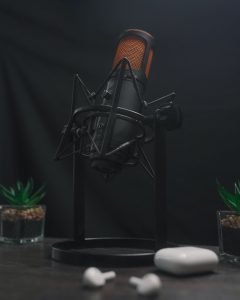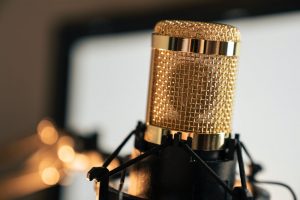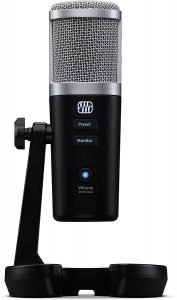If you’re looking for a high-performance microphone without any of the bulky sizes, you should check out our guide on small-diaphragm condenser microphones.
These are all of great quality, and they’ll give you fantastic sound.
When it comes to recording vocals, for example, a good mic can really make or break your project.
What is a small diaphragm condenser microphone?
When it comes to condenser microphones, you have a few main types to choose from, including: large diaphragm condensers, small diaphragm condensers, and ribbon mics.
Small Condenser Mics – A small diaphragm microphone uses a smaller capsule inside than a large diaphragm does. That allows the microphone to capture great detail- especially in the high-end frequencies. The downside to this is that they sometimes create more noise than other microphone types.
How do they work?
Condenser microphones can be polar (they can only record sound in front of them) or omnidirectional (they can record sound from all around).
The way a condenser microphone works is simple- the diaphragm inside the capsule moves backward and forward as it picks up sound. The signal is passed from the diaphragm to the back of the microphone where a transducer turns vibrations into an electrical signal. It’s then amplified and sent to your recording device.
Why would you want to use one over another type of mic?
Condenser mics are great for a variety of different applications, and they’re the type that’s typically used for recording vocals. The high-end frequencies are often very clear-cut when it comes to small-diaphragm condensers.
Why are they good for recording vocals and instruments?
These microphones often have a larger frequency response range than other types of mics, which makes them a great all-around choice and they’re great for recording vocals and instruments.
How do they compare to large diaphragm condenser microphones?
Large-diaphragm condenser microphones often provide you with a warmer sound and a midrange that’s easier to hear. Small diaphragm microphones generally have a brighter sound with more presence in the upper end of the frequency range.
Table of Contents
6 Best Small Diaphragm Condenser Microphones
1. Shure SM81-LC Cardioid
Shure SM81-LC has a cardioid pickup pattern and is typically used for high output instruments like saxophone and guitar. This mic is also effective as a vocal microphone. The frequency range of the SM81-LC mic is 50 to 20,000 Hz. Its sensitivity level is -54 dBV/Pa. This model also has a low self-noise level of 9 dB(A). It offers smooth, natural sound quality with a clear articulation.
2. PreSonus Revelator
PreSonus Revelator Mic comes at an affordable price. This mic offers a frequency response of 20Hz to 20kHz and a sensitivity of -29dB. It also has an impedance of 47kΩ and it is powered by USB. The PreSonus Revelator Mic can be used in pop, jazz, classical, country and electronic music genres. It has a cardioid pickup pattern and is typically used for high output instruments like saxophone and guitar. This mic is also effective as a vocal microphone. The self-noise level of it is 14dB(A).
3. Rode Procaster Broadcast 
The Rode Procaster Mic is a dynamic microphone, which means that it has a cardioid pickup pattern, and because it is dynamic, the frequency response of this mic is 50Hz to 20kHz with a sensitivity of -57dB and an impedance of 150Ω. The sound pressure level of the Rode Procaster Mic is 135dB. It comes with a 10 year warranty. This microphone has been used in TV shows, YouTube videos and broadcasting stations. It has a gold-plated 4-pin XLR connector with a tungsten audio jack and a foam windscreen that helps to reduce wind noise. This mic is commonly used for recording vocals, drums, percussion and acoustic instruments.
4. Neumann KM 184
Neumann KM 184 comes with easy-to-use controls. This mic is also known for having a wide range of applications. It can be used as an instrument, vocal or room microphone. It has a wide frequency response of 20Hz to 20kHz and it can capture details. It is great for vocals because it offers good articulation and a smooth sound. This microphone comes with a 20 year warranty and will last for years to come.
5. Mackie USB (EM-91CU)
The Mackie Condenser USB Mic is perfect for small and big projects. This mic offers a frequency range of 30Hz to 20kHz with a sensitivity of -36dB. It has an impedance level of 200Ω and a 1/8-inch connector. The power source for this mic is USB powered so you won’t have to worry about finding any batteries. In addition, this microphone has an XLR adapter.
6. sE Electronics sE8
The sE Electronics sE8 Small Diaphragm Condenser Microphone is ultra-light and portable. It has a cardioid pickup pattern and it is equipped with a 1-inch gold sputtered diaphragm. This microphone has a sensitivity of -34dB, an impedance of 200Ω and an SPL rating of 137dB. This mic comes with a windscreen and it is ideal for recording instruments, vocals, voice-overs and more.
FAQs
Are small diaphragm mics good for vocals?
It’s all in the application. If you are recording a small body acoustic-electric guitar, a diaphragm condenser mic should not be your first option. However, for a voice, small-diaphragm condensers are an extremely versatile tool. They are excellent for recording with very little proximity effect and quick transient response. It is also a good idea to match the microphone to the singer. A small diaphragm condenser will have a brighter tone than a large diaphragm vocal mic.
What are small-diaphragm condenser mics for?
Small diaphragm mics can be used for virtually any situation in the studio. Small diaphragm condensers are great for creating an intimate sound with a singer or player. In addition to their ability to make a voice feel more “alive”, small-diaphragm condensers are also good at capturing the subtle nuances of acoustic guitars and other instruments.
FAQ:
Q: What is a good condenser microphone?
A: – Condenser Microphones Market Insights – Condenser Microphones Market Size and Forecast by Type – Condenser Microphones Market Size and Forecast, by Component – Condenser Microphones Market Size and Forecast, by Environment – Condenser Microphones Market Size and Forecast, by End-User – Condenser Microphones Market Size and Forecast, by Region
Q: Should I use a condenser or dynamic microphone?
A: That’s why you should use a condenser mic only on instruments with low-to-mid SPLs. So condenser mics are best used in the recording studio on things like vocals and acoustic guitars, not during a live performance. Dynamic mics usually work better on low-to-mid frequency instruments, like drums and electric guitar amps.
Q: What is small diaphragm mic?
A: What is the difference between large and small diaphragm mics? A rule of thumb is that a large diaphragm — or capsule membrane — is one inch or more in diameter. A small diaphragm means it is half-inch or less in diameter. Small diaphragm condensers usually are slim, pencil-shaped and operate end-fired.
Q: What is a condenser on a microphone?
A: Condenser microphones use the electrostatic principle to create a charged structure that functions as a capacitor. The structure is the microphone capsule and is made up of two thin plates of equal size and surface area. The top plate, or diaphragm, is moveable; the backplate stays in a fixed position. Both plates are separated by a dielectric …







